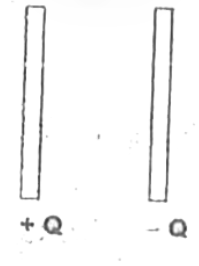STATEMENT-1: When an uncharged parallel-plate capacitor is charged by conneting it to a cell, the heat produced in the circuit is equal to the energy stored in the capacitor.
STATEMENT-1: The charge on a parallel-plate capacitor means the equal and opposite charges, on its inner surfaces.
A
Statement-1 is True, Statement-2 is True, Statement-2 is a correct explanation, for Statement-1.
B
Statement-1 is True, Statement-2 is True, Statement-2 is not a correct explanation for Statement-1.
C
Statement-1 is True, Statement-2 is False.
D
Statement-1 is a False, Statement-2 is True.
Text Solution
The correct Answer is:B
|
Updated on:21/07/2023
Related Playlists
Knowledge Check
- Question 1 - Select One
A parallel plate capacitor is charged. If the plates are pulled apart
Athe potential difference increasesBthe capacitance increasesCthe total charge increasesDthe charge and the potential difference remain the same - Question 1 - Select One
A parallel plate capacitor C has a charge Q. The actual charges on its plates are
AQ,QBQ/2, Q/2CQ,-QDQ/2. - Q/2 - Question 1 - Select One
When a charged capacitor is discharged through a resistor, heat is produced in the resistor
In charging a capacitor, energy is stored in the capacitor.ABoth A and R falseBBoth A and R true and R is not correct reason for ACA is true and R is falseDBoth A and R are true and R is correct reason of A. - Question 1 - Select One
If the plates of a parallel plate capacitor are not equal in area then quantity of charge
AOn the plates will be same but nature of charge will differBOn the plates as will as nature of charge will be differentCOn the plates will be different but nature of charge will be sameDAs well as nature of charge will be same - Question 1 - Select One
A parallel plate capacitor is charged and then isolated. On increasing the plate separation
A Charge Potential Difference Capacitanceremains constant remains constant decreasesB Charge Potential Difference Capacitanceremains constant increases decreasesC Charge Potential Difference Capacitanceremains constant decreases increasesD Charge Potential Difference Capacitanceincreases decreases increases
Similar Questions
A parallel plate capacitor is charged. If the plates are pulled apart
View SolutionConsider a parallel plate capacitor having charge Q. Then,
 View Solution
View SolutionA parallel plate capacitor is charged and then isolated. On increasing the plate separation
View SolutionA parallel plate capacitor is charged and then isolated. On increasing the plate separation
View SolutionA parallel plate capacitor having plate area A and separation between the plates d is charged to potential V.The energy stored in capacitor is ....???
View Solution

